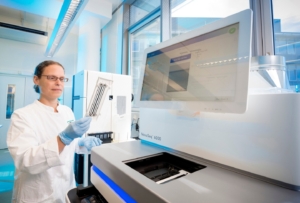German Cancer Research Centre plans to use quantum computer to personalise cancer treatment
As a partner of the Fraunhofer Competence Network Quantum Computing, the German Cancer Research Center is planning to use the quantu m computer in Ehningen, Baden-Württemberg, to develop individually effective cancer treatment methods.
Cancer patients’ medical records can often comprise up to 100 terabytes of individual – and usually very heterogeneous – data, including blood and tumour values, personal indicators, sequencing and treatment data, and much more besides. Up to now, it has been virtually impossible to use this wealth of information efficiently due to a lack of appropriate processing mechanisms. As a result, the possibility of using promising personalized treatment approaches remains purely theoretical for many cancers, and patients are still receiving standard treatments.
Now, the German Cancer Research Center (DKFZ) in Heidelberg – the largest biomedical research institution in Germany with more than 1300 scientists studying cancer – is planning to use quantum computing to drive forward research in this area: “We want to explore how we can systematically process and use this heterogeneous data with the aid of a quantum computer, so that we can identify new and more targeted options for patients who do not respond so well to immunotherapies. Ultimately, we are asking which patient can benefit from which treatment and how,” said Dr. Niels Halama, Head of Department of Translational Immunotherapy at the German Cancer Research Center (DKFZ) and Senior Physician at the German National Center for Tumor Diseases. Linked to this topic are some applied research questions: Which signalling cascades and biological processes play a role in the disease? How can we use these to select a treatment on an individual basis? What kinds of problems actually lend themselves to being solved by quantum computers?
From a simulator to a real quantum computer
The DKFZ team has already worked out the mathematical principles and carried out some initial work using other globally available systems and simulators. According to Halama, however, there is a huge difference between working on a simulator with perfect qubits and working on a real quantum computer such as IBM Q System One in Ehningen. It is only with the latter that you can see how stable things are at a certain level of complexity, where the pitfalls are and what is possible.
The researchers now want to use the Ehningen system to further develop and flesh out their ideas via an application-oriented approach. The aim is to find out which algorithms are suitable for processing the information in question and how they can be adapted or redeveloped as necessary – but also how, for example, error corrections can be optimized further. The DKFZ team is still looking for more cooperation partners from various fields of research and industry to enable an interdisciplinary investigation into the possibilities that quantum computing offers in the area of new cancer treatment approaches.
“We are very pleased to have DKZF as a collaborative partner,” said Prof. Raoul Klingner, Director of Research Management and Governance at the Fraunhofer-Gesellschaft. “The use of quantum computing in a field as complex and significant as personalized cancer therapy highlights the potential that quantum computing offers for medicine and numerous other industries.”
Three important criteria
For Halama, there are three important criteria when working with the quantum computer: data protection, speed and flexibility. The scientists are still working with test data at the moment, but when real patient data is used in the future, “it will be very advantageous that the Ehningen quantum computer operates under German data protection legislation and that the data remains on site,” said the physician. The speed of calculations, which could make quantum computing superior to conventional computing in the future, is another key criterion because – when it comes to cancer patients – every day counts and decisions need to be made quickly. As quantum processors can process data in parallel rather than in succession, they have the potential to analyse huge volumes of data in a fraction of the time that normal computers require.
According to Halama, the flexible monthly ticket model that the Fraunhofer Competence Network Quantum Computing offers to its partners is also an important factor. “It allows us, as an academic institution, to use the system flexibly as and when needed without having to invest huge sums over a long period,” he said. “Furthermore, Fraunhofer is an important scientific partner for us and our collaboration allows us to bridge the gap between theoretical and applied research for the benefit of the patient.”


